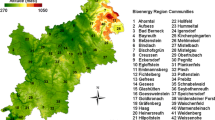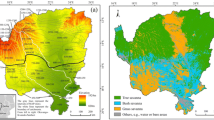Abstract
A daily model of terrestrial productivity is used to simulate the annual productivity of heterogeneous vegetation structure at three savanna/woodland sites along a large moisture gradient in southern Africa. The horizontal distributions of vegetation structural parameters are derived from the three-dimensional canopy structure generated from detailed field observations of the vegetation at each site. Rainfall and daily climatic data are used to drive the model, resulting in a spatially explicit estimate of vegetation productivity in 100 m2 patches over an area 810,000 m2 (8,100 patches per site). Production is resolved into tree and grass components for each subplot. The model simulates the relative contribution of trees and grasses to net primary productivity (NPP) along the rainfall gradient. These simulated production estimates agree with previously published estimates of productivity in southern African savannas. Water-use efficiency of each site is directly related to the structural composition of the site and the differing water-use efficiencies for tree and grass functional types. To assess the role of spatial scale in governing estimates of vegetation productivity in heterogeneous landscapes, spatial aggregation is performed on the canopy mosaic at the northern-most (wettest) site for 625 m2, 2500 m2 and 5625 m2 resolutions. These simulations result in similar overall patterns of average NPP for both trees and grasses, but drastically reduced distributions of productivity due to reduced structural heterogeneity. In particular, the aggregation of the detailed spatial mosaic to coarser resolutions is seen to eliminate information regarding demographic processes such as regeneration and mortality, and the dependence of grass productivity on over-story density. These results indicate that models of system productivity in savanna/woodland ecosystems must retain high spatial resolution to adequately characterize multi-year structural responses and to accurately represent the contribution of grass biomass to overall ecosystem production.
Similar content being viewed by others
References
Asner G.P., Bateson C.A. and Wessman C.A. 1998. Estimating vegetation structural effects on carbon uptake using satellite data fusion and inverse modeling. Journal of Geophysical Research 103: 28–39.
Ball J.T., Woodrow I.E., and Berry. J.A. 1987. A Model Predicting Stomata Conductance and its Contribution to the Control of Photosynthesis Under Different Environmental Conditions. In: Biggens J. (ed.), Progress in Photosynthesis Research, Vol. IV. Martinus Nijhoff Publishers, Dordrecht, The Netherlands.
Belsky A.J., Mwonga S.M., Amundson R.G., Duxbury J.M. and Ali A.R. 1993. Comparative effects of isolated trees on their under-canopy environments in high and low-rainfall savannas. Journal of Applied Ecology 30(1): 143–155.
Belsky A.J. 1994. Influences of trees on savanna productivity: Tests of shade, nutrients and tree-grass competition. Ecology 75: 922–932.
Campbell G.S. and Norman J.M. 1998. An Introduction to Environmental Biophysics, 2nd edition. Springer-Verlag, New York, New York, USA.
Caylor K., Shugart H. and Smith T.M. 2003. Tree spacing along the Kalahari Transect. Journal of Arid Environments 54(2): 281–296.
Caylor K.K., Dowty P.R., Shugart H.H. and Ringrose S. in press. Vertical patterns of vegetation structure along the Kalahari Transect: The importance of spatial heterogeneity in modeling system productivity. Global Change Biology.
Cook G.D., Williams R., Hutley L.B., O’Grady A. and Liedloff A. 2002. Variation in vegetation water use in the savannas of the North Australian Tropcial Transect. Journal of Vegetation Science 13(3): 413–418.
Dowty P., Caylor K.K., Shugart H., and Emanuel W.R. 2000. Approaches for the estimation of primary productivity and vegetation structure in the Kalahari region. In: Ringrose S. and Chanda R. (eds), Towards Sustainable Natural Resource Management in the Kalahari Region. University of Botswana, Gaborone, Botswana.
Dowty P.R. 1999. Modeling Biophysical Processes in the Savannas of Southern Africa. PhD. University of Virginia, Charlottesville, Virginia, USA.
Dye P.J. and Spear T. 1982. The Effects of Bush Clearing and Rainfall Variability on Grass Yield and Composition in South-West Zimbabwe. Zimbabwe Journal of Agricultural Research 20: 103–118.
Farquhar G.D., von Caemmerer S. and Berry J.A. 1980. A Biochemical Model of Photosynthetic CO2 Assimilation in Leaves of C3 Species. Planta 149: 78–90.
Gholz H.L., Nakane K. and Shimoda H. 1997. The use of remote sensing in the modeling of forest productivity. Kluwer Academic Publishers, Dordrecht; Boston.
Golluscio R.A., Sala C.E. and Lauenroth W.K. 1998. Differential use of large summer rainfall events by shrubs and grasses: a manipulative experiment in the Patagonian steppe. Oecologia 115: 17.
Goodman P.S. 1990. Soil, Vegetation and Large Hebivore Relations in Mkuzi Game Reserve, Natal. PhD. University of the Witwatersrand.
Harley P.C., Thomas R.B., Reynolds J.F. and Strain B.R. 1992. Modelling photosynthesis of cotton grown in elevated CO2. Plant, Cell and Environment 15: 271–282.
Haxeltine A. and Prentice I.C. 1996. A general model for the light-use efficiency of primary production. Functional Ecology 10: 551–561.
Hély C., Caylor K.K., Dowty P.R., Alleaume S., Korontzi S., Korontzi S., Swap R.J., Shugart H.H. and Justice C.O. in review. A temporal and spatially explicit fuel load model for savannas in southern Africa. Journal of Ecological Modelling.
Jeltsch F., Milton S., Dean W.R.J. and v. Rooyen N. 1996. Tree spacing and coexistence in semiarid savannas. Journal of Ecology 84: 583–595.
Jeltsch F., Milton S.J. and Moloney K.A. 1998. Modelling the impact of small-scale heterogeneities on tree-grass coexistence in semi-arid savannas. Journal of Ecology 86: 780.
Jones H.G. 1992. Plants and microclimate: a quantitative approach to environmental plant physiology. Cambridge University Press, Cambridge, New York, USA.
Koch G.W., Vitousek P.M., Steffen W.L. and Walker B.H. 1995. Terrestrial transects for global change research. Vegetatio 121: 53–65.
Larcher W. 1995. Physiological plant ecology: ecophysiology and stress physiology of functional groups. Springer-Verlag, Berlin; New York.
Medlyn B.E. 1998. Physiological basis of the light use efficiency model. Tree Physiology 18: 167–176.
Pearcy R.W. and Ehleringer. J. 1984. Comparative Ecophysiology of C3 and C4 plants. Plant, Cell and Environment 7: 1–13.
Porporato A., Laio F., Ridolfi L., Caylor K.K. and Rodriguez-Iturbe I. in review. Modeling the probability distribution function of soil moisture along the Kalahari Transect. Journal of Geophysical Research — Atmospheres.
Prince S.D. 1991. A model of regional primary production for use with coarse resolution satellite data. International Journal of Remote Sensing 12: 313–1330.
Privette J.L., Myneni R.B., Knyazikhin Y., Mukelabai M., Roberts G., Tian Y., Wang Y. and Leblanc S.G. 2002. Early spatial and temporal validation of MODIS LAI product in the southern Africa Kalahari. Remote Sensing of Environment. 83(12): 232–243.
Privette J.L., Tian Y., Roberts G., Scholes R.J., Wang Y., Caylor K.K., Frost P. and Mukelabai M. in press. Vegetation structure characteristics and relationships of Kalahari woodlands and savannas. Global Change Biology.
Rodriguez-Iturbe I., D’Odorico P., Porporato A. and Ridolfi. L. 1999. On the spatial and temporal links between vegetation, climate, and soil moisture. Water Resources Research 35: 3709–3722.
Scanlon T.M. and Albertson J.D. in press. Canopy scale measurements of CO2 and water vapor exchange along a precipitation gradient in southern Africa. Global Change Biology.
Scholes R.J., Dowty P.R., Caylor K., Parsons D.A.B., Frost P.G.H. and Shugart H.H. 2002. Trends in savanna structure and composition on an aridity gradient in the Kalahari. Journal of Vegetation Science 13: 419–428.
Scholes R.J. and Archer S.R. 1997. Tree-grass interactions in Savannas. Annual Review of Ecology and Systematics. 28: 517–544.
Scholes R.J. and Hall D.O. 1996. The Carbon Budget of Tropical Savannas, Woodlands and Grasslands, Pages 69–100. In: Breymeyer A.I., Hall D.O., Melillo J.M. and Agren G.I. (eds), Global Change: Effects on Coniferous Forests and Grasslands. John Wiley and Sons Ltd.
Scholes R.J., and Vanbreemen N. 1997. The Effects of Global Change On Tropical Ecosystems. Geoderma 79: 9–24.
Scholes R.J. and Walker B.H. 1993. An African Savanna: Synthesis of the Nylsvley Study. Cambridge University Press, Cambridge, UK.
Sellers P.J., Randall D.A., Collatz G.J., Berry J.A., Field C.B., Dazlich D.A., Zhang C., Collelo G.D. and Bounoua L. 1996. A Revised Land Surface Parameterization (SiB2) for Atmospheric GCMs. Part I: Model Formulation. Journal of Climate 9: 676–705.
Shugart H.H. 1984. A Theory of Forest Dynamics. Springer-Verlag, New York, New York, USA.
Shugart H.H. 1998. Terrestrial Ecosystems in Changing Environments. Cambridge University Press, New York, New York, USA.
Skarpe C. 1991. Spatial patterns and dynamics of woody vegetation in an arid savanna. Journal of Vegetation Science 2: 565–572.
Smit G.N. and Rethman N.F.G. 2000. The influence of tree thinning on the soil water in a semi-arid savanna of southern Africa. Journal of Arid Environments 44: 41–59.
Smith T.M., and Goodman P.S. 1986. The effect of competition on the structure and dynamics of Acacia savannas in southern Africa. Journal of Ecology 74: 1031–1044.
Thomas D.S.G. and Shaw P.A. 1991. The Kalahari Environment. Cambridge University Press, Cambridge, UK.
Walker B.H. 1987. Determinants of tropical savannas. IRL Press, Oxford, UK.
Woodward F.I. and Smith T.M. 1994. Global photosynthesis and stomatal conductance: Modelling the controls by soils and climate. Advances in Botanical Research 20: 1–41.
Woodward F.I., Smith T.M. and Emanuel W.R. 1995. A global land primary productivity and phytogeography model. Global biogeochemical cycles 9: 471–490.
Author information
Authors and Affiliations
Rights and permissions
About this article
Cite this article
Caylor, K.K., Shugart, H.H. Simulated productivity of heterogeneous patches in Southern African savanna landscapes using a canopy productivity model. Landscape Ecol 19, 401–415 (2004). https://doi.org/10.1023/B:LAND.0000030450.11302.c2
Issue Date:
DOI: https://doi.org/10.1023/B:LAND.0000030450.11302.c2




